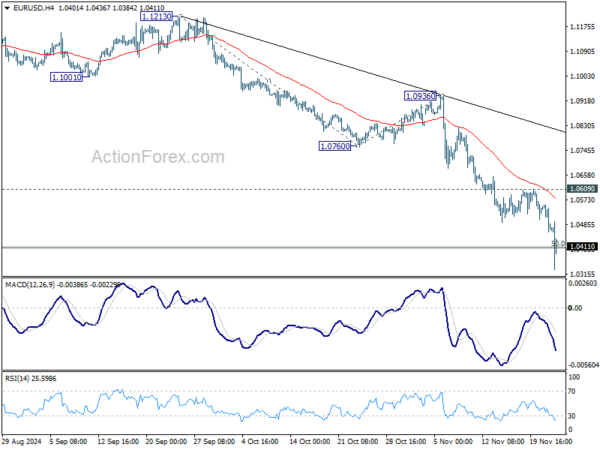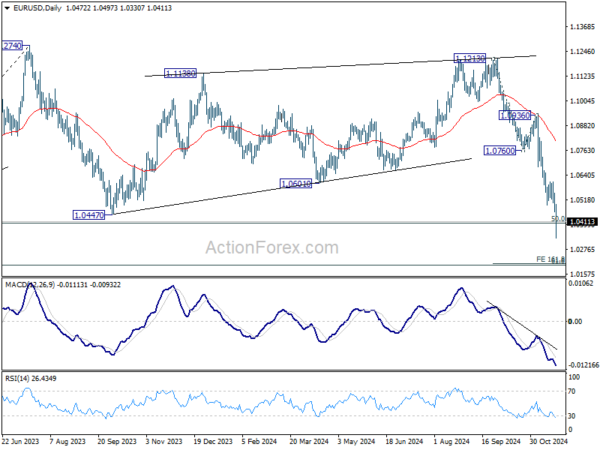Euro and Sterling Under Fire after PMIs, Swiss Franc Reverses Gains – Action Forex
European majors are experiencing significant selling pressure today, with Euro leading the declines. Euro sharply depreciated as traders increased their bets on an aggressive 50 bps rate cut by ECB in December, following dismal PMI data. Market expectations for such a cut have surged to 50%, a substantial rise from around 15% just a day earlier. The region’s services sector has now entered contraction, aligning with the manufacturing sector’s prolonged recession. This economic downturn is further exacerbated by escalating geopolitical risks, notably the escalation of the Ukraine war, and the looming threat of tariffs from US President-elect Donald Trump. These factors intensify the urgency for ECB to accelerate its monetary easing towards a neutral rate to support the faltering economy.
Sterling is also under substantial strain, weighed down by a larger-than-expected contraction in UK retail sales and disappointing November PMI readings. S&P Global observed that business sentiment in the UK has been declining since the general elections earlier this year. The Labour government’s Autumn Budget failed to boost confidence, with sentiment instead plunging sharply. This suggests that the worst may still be ahead for the UK economy, as consumer spending weakens and businesses express growing concern over economic policies.
Swiss Franc initially spiked higher against Euro and Sterling earlier in the day. However, it reversed those gains after SNB Chairman Martin Schlegel emphasized that negative interest rates remain a possibility. The SNB is currently expected to cut interest rates by 25 basis points in December. Yet, the situation is fluid; a larger cut by ECB could prompt SNB to respond similarly to prevent excessive appreciation of the Franc. The complexity of this monetary chess game is heightened by the fact that both central banks will announce their decisions on the same day, December 12.
As the week nears its conclusion, Euro is the worst performer among major currencies, followed by Sterling and Swiss Franc. However, late-week developments could still alter this ranking. On the other hand, Canadian Dollar is firmly in the lead as the strongest currency, supported additionally by robust retail sales data. Australian Dollar and Japanese Yen follow, while Dollar and New Zealand Dollar occupy middle positions.
Canada retail sales rises 0.4% mom in Sep, 0.7% mom in Oct
Canada’s retail sales rose by 0.4% mom in September to CAD 66.9B, slightly above market expectations of a 0.3% mom increase. Gains were observed in six out of nine subsectors, with food and beverage retailers leading the growth.
Core retail sales, which exclude gasoline and motor vehicle-related sectors, surged by a robust 1.4% mom, highlighting strength in consumer discretionary spending.
For Q3, retail sales climbed 0.9%, with a 1.3% increase in volume terms, suggesting solid economic activity during the period.
The advance estimate for October indicates a further 0.7% mom rise, reinforcing signs of resilience in consumer demand.
Eurozone PMI signals stagflation as both manufacturing and services contract
Eurozone economic activity weakened sharply in November, with PMI Manufacturing falling to 45.2 from 46.0 and PMI Services dropping to 49.2 from 51.6, pushing Composite PMI to a 10-month low of 48.1, down from 50.0. For the first time since January, both sectors recorded output declines, reflecting broader economic struggles.
Country-level data painted a bleak picture. France saw its Composite PMI drop to 44.8, with Manufacturing PMI at 43.2 and Services PMI at 45.7—both hitting 10-month lows. Germany’s Composite PMI fell to 47.3, a 9-month low, with Services PMI sliding into contraction at 49.4 despite a slight improvement in Manufacturing PMI, which edged up to 43.2.
Cyrus de la Rubia of Hamburg Commercial Bank highlighted “stagflationary” conditions, with falling activity alongside rising input and output prices driven by service sector costs and wage growth. He pointed to political instability in France and Germany and global uncertainties, including potential US tariffs, as key contributors.
UK PMI composite fall to 49.9, slips into contraction as post-budget sentiment worsens
UK economic activity weakened in November, with the Composite PMI falling from 51.8 to 49.9, its first contraction in 13 months. Manufacturing PMI declined to a 9-month low of 48.6, down from 49.9, while Services PMI hit a 13-month low at 50.0, down from 52.0.
Chris Williamson of S&P Global Market Intelligence noted that businesses are reporting falling output and employment cuts for the second consecutive month. Post-budget sentiment has deteriorated sharply, with optimism now at its lowest since late 2022. Companies have expressed significant concern over the announced increase in employers’ National Insurance contributions.
The November data suggest the economy is contracting modestly, with GDP estimated to decline at a quarterly rate of -0.1%. Williamson warned of the potential for further job losses unless sentiment improves.
On the inflation front, selling price growth slowed to its lowest post-pandemic rate, but elevated wage pressures in services remain a challenge, likely tempering the case for aggressive rate cuts by BoE.
UK retail sales drop sharply by -0.7% mom in Oct, but broader trends show resilience
UK retail sales volumes plunged by -0.7% mom in October, significantly underperforming expectations of a -0.3% mom decline. Also, volumes remained -1.5% below their pre-pandemic level in February 2020.
On a broader basis, retail activity was more encouraging. Sales volumes increased by 0.8% in the three months to October compared to the preceding three months. When measured against the same period last year, sales volumes grew by 2.5%. This represents the strongest annualized growth since March 2022, despite a downward revision of September’s annual figure from 2.6% to 2.1%.
Japan’s CPI eases to 2.3% in Oct, core-core rises to 2.3%
Japan’s inflation data for October revealed persistent and broadening price pressures. Core CPI (excluding food) eased slightly to 2.3% yoy, down from 2.4% yoy but exceeding expectations of 2.2% yoy. This marked the 31st consecutive month core CPI has stayed at or above BoJ’s 2% target.
Core-core CPI (excluding food and energy) rose from 2.1% yoy to 2.3% yoy, underscoring renewed strength in underlying inflation. Headline CPI moderated from 2.5% to 2.3%, partly due to slowing energy price gains, which decelerated sharply to 2.3% yoy from 6.0% yoy in September. However, food prices surged 3.8% yoy, accelerating from 3.1% yoy, while services prices edged up to 1.5% yoy from 1.3% yoy.
The combination of steady inflation momentum, recovering consumer spending, and Ten’s renewed weakening bolsters the argument for a BoJ rate hike at its upcoming policy meeting in December.
Japan’s PMI manufacturing falls to 49.0, services rises to 50.2
Japan’s PMI Manufacturing index edged down to 49.0 from 49.2 in November, signaling a deepened contraction in the sector. In contrast, PMI Services rose slightly to 50.2 from 49.7, indicating a renewed, albeit modest, expansion. PMI Composite improved marginally but remained below the neutral mark at 49.8, up from 49.6.
Usama Bhatti, Economist at S&P Global Market Intelligence, noted that demand conditions were “stagnant,” while employment grew at the fastest rate in four months. Price pressures persisted across sectors, driven by rising raw material costs and Yen’s weakness. Firms responded with sharper increases in prices charged for goods and services, aiming to pass on these higher cost burdens to customers.
Australia’s PMI composite falls to 49.4, second contraction in three months
Australia’s PMI Manufacturing improved sharply from 47.3 to 49.3 in November, marking a six-month high but remaining in contraction territory. Conversely, PMI Services index dropped from 51.0 to 49.6, hitting a 10-month low and signaling contraction. PMI Composite fell from 50.2 to 49.4, its lowest level in 10 months, indicating a slight overall contraction in private sector output for the second time in three months.
Jingyi Pan, Economics Associate Director at S&P Global Market Intelligence, highlighted the significance of the services sector’s slowdown. “The November S&P Global Flash Australia PMI posted the lowest reading since January, bringing the fourth-quarter average thus far below that of the prior quarter,” Pan said.
The report also noted that easing capacity pressures and subdued activity contributed to slower employment growth, which fell further below the long-term average. In addition, selling price inflation eased as businesses showed caution in raising charges. This combination of softer employment growth and reduced price pressures supports expectations of lower interest rates.
EUR/USD Mid-Day Outlook
Daily Pivots: (S1) 1.0439; (P) 1.0497; (R1) 1.0532; More…
EUR/USD’s decline accelerated to as low as 1.0330 so far and there is no sign of bottoming yet. Sustained trading below 1.0404 key fiboncci level will carry larger bearish implications. Next target will be 161.8% projection of 1.1213 to 1.0760 from 1.0936 at 1.0203. Nevertheless, strong rebound from current level, followed by break of 1.0609 resistance, will confirm short term bottoming.
In the bigger picture, immediate focus is now on 50% retracement of 0.9534 (2022 low) to 1.1274 at 1.0404. Strong rebound from this level will keep price actions from 1.1273 (2023 high) as a medium term consolidation pattern only. However, sustained break of 1.0404 will raise the chance that whole up trend from 0.9534 has reversed. That would pave the way to 61.8% retracement at 1.0199 and below.


